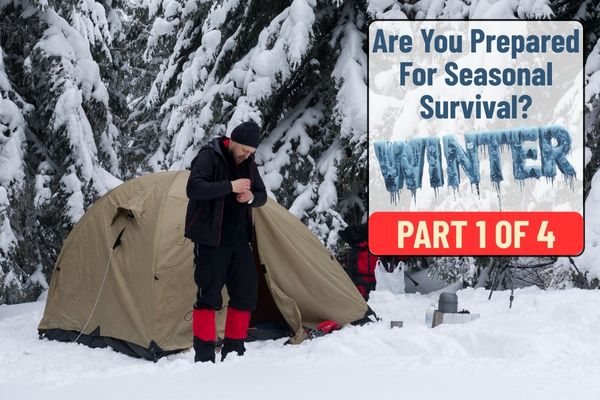How to Prepare For Winter
Even the most seasoned prepper will want to re-evaluate prepping supplies and skills when a new season is approaching.
If you live in a cold weather winter climate, snowstorms, blizzards. and ice storms bring on a whole new set of challenges during a disaster scenario.
The time to prepare for winter is as soon as the summer months come to a close. Consider prepping scenarios that can be affected by cold, inclement weather.
Here are 10 ways to prepare for winter prepper scenarios.
<1> Switching Out Essentials in Bugout Bag
Prior to a new season is a good time to unpack your bugout bag completely to evaluate your prepper essentials. The winter months (where you may encounter frigid temperatures, windy conditions, snow, sleet, or hail) will require different supplies.
For example, remove the bug spray and sunblock and replace it with hand and toe warmers. Remove a personal fan and replace it with insulated thermal blankets. Replace a lightweight windbreaker with a down jacket, scarves, sweaters, and thick socks. Hiking boots could be used year-round, but be sure they have an efficient waterproof exterior and no rips or tears that could be infiltrated by snowy or wet terrains.
<2> Rotate and Update the Prepper Food Supply
As with your bugout bag, an impending new season is also the ideal time to take your food supply expiration dates. Move foods up to the front based on “best by” dates. Any foods that have a very soon “best by” date, add to your current food pantry and enjoy eating or drinking it now.
This is a good time for you to add winter-related foods like canned soups, stews, and chili-types of hearty non-perishable food items. Also, be sure you stock up on powdered milk to be ready for power losses that typically occur during winter storms.
While you’re rotating and updating your prepper food supply, take some time to stock up on paper goods like toilet paper, tissues, and paper towels.
<3> Add Winter Tools to Your Prepper Storage Closet
You may already have a comprehensive prepper storage closet filled with everything you’ll need for a summer bug-in situation. Now is the best time for you to add some essential winter tools that can assist you with snow, ice, and cold temperatures. You don’t want to be caught off guard when a snowstorm or blizzard hits. Start out by investing in sturdy snow shovels, rock salt, ice melt, ice scrapers, and more. If you have the room, you can invest in an electric shovel, snow thrower, or snow blower.
It’s important for you to have space in your garage to park your car during a snowstorm. That way, you can quickly pack up the car and drive away in case of an emergency evacuation or bugout situation. In a serious emergency, the last thing you would want to do is remove snow and ice from the windows. And the time it takes for you to dig your vehicle out of snow may take up precious evacuation time. The same holds true for keeping the driveaway clear of snow.
<4> Prepare for Power Outages
In your prepper supply, you may already have flashlights, battery-operated lanterns, solar lights, crank radio, candles, matches or a fire starter to supply light during a power outage. However, for a long-term power outage, you may consider investing in a battery-operated or gas-powered generator to keep your devices charged. Also, always keep lighting sources in an accessible location so you can find them with ease. Always check for working batteries and have spares on hand.
As you probably already do, make sure your mobile devices are charged fully should a winter storm be forecasted. If you purchased a generator or other back-up devices that don’t require electrical power, ensure that you know how to operate these devices prior to an emergency scenario. Obviously, if it’s a gas-powered generator, be sure to have an adequate supply of gas on hand to operate the machine.
<5> Building a Temporary Cold Weather Shelter
If you’re lucky enough to bug-in during a disaster scenario or winter storm, you will have the benefit of a secure shelter with all your prepper supplies on hand. However, if you need to evacuate or bugout, you’ll want to have important supplies on hand to build a winter-proof temporary shelter.
Building a shelter in the winter months needs to be more than just draping a single tarp over a rope or tree branch. You’ll want to create a fully enclosed square shape shelter low to the ground to protect yourself and your family from snow, wind, and frigid temperatures. Be sure you have ponchos, tarps, wire, and cordage (and be prepared to find materials in the wild such logs, large branches from pine or fir trees, rocks, and leaves). If you can, find a very tall evergreen type of tree and build your shelter below the bottom branches that can overhang your shelter structure to provide added protection from harsh elements. For extra warmth inside the temporary shelter, place multiple insulated blankets and sleeping bags amidst a bed of dry leaves (if possible) or on top of a waterproof tarp. In addition to wearing winter weather clothing, use hand warmers and toe warmers that should be placed in bugout bags.
<6> Winterize Your Home and Trim Overhanging Branches
When the winter months approach, it’s a good idea to remove small garden décor and other decorations from your outside property. You don’t want the snow to cover such items and then in an emergency you risk falling while you’re desperately trying to maneuver around the property.
Hire a tree service to remove large tree branches that overhang your home. Winter storms that drop heavy snow on trees also typically produce strong wind gusts and you don’t want to risk a large branch snapping off and thereby damaging your roof, property, or putting your family in danger. Also, make sure you turn off and cover any outdoor water faucets to keep water from freezing in the pipes. You don’t want to contend with plumbing issues during a bug-in situation.
<7> Building a Fire in the Fireplace and Outdoors
Whether you’re bugging in at home or bugging out in the wild, you want to be sure that you are fully prepared to keep your family as warm and comfortable as possible. If you have a fireplace in your home, ensure you have enough firewood to warm your family during a long-term power loss. Be sure the fireplace, damper, and flue are clean and working properly.
If you’re bugging out, be sure you know how to start a fire to not only provide warmth but to cook food as well. Make sure you have a fire starter or matches in your bugout bag. Since you won’t be able to carry firewood in your bugout bag, practice how to start a fire from tree branches, leaves, and other plant debris.
And speaking of fires, while you’re prepping the fireplace, take some time to check that the fire extinguishers in your home are in working order. It’s always a good idea to have a fire extinguisher on hand, especially when operating a fireplace.
<8> Learn Cold Weather First Aid
Preppers should know how to administer first aid, and they should also have a well-stocked first aid kit. When bugging out during warm weather months, you may be called upon to treat insect bites, sunburn, dehydration, seasonal allergies, and other ailments. However, in winter months, you will need to know how to treat illnesses like colds and the flu, in addition to frost bite and hypothermia.
Hypothermia and frostbite happen when the body temperature drops dangerously low from prolonged exposure to cold temperatures. Without quick intervention, frostbite can lead to permanent damage and eventual loss of extremities. To help the victim, find dry shelter where you can warm the frostbitten body parts gradually using body heat and blankets. Then, replace wet clothing with dry clothing in addition to providing warm hydration. Dehydration worsens the body’s circulation. One note: Never rub frostbitten skin; be gentle.
To ensure that you’re qualified to provide winter-related first aid, take a first aid course or watch a first-aid tutorial online to learn how to immediately recognize the symptoms of hypothermia and frostbite and effectively provide treatment.
<9> Prepare Vehicles and Outdoor Machines
It would be stressful enough to face an unexpected emergency bugout scenario, but even worse would be if your vehicle malfunctioned and you were stranded in the snow in freezing temperatures. Get your vehicle serviced before the winter weather arrives. This includes tires, battery, brakes, cables, windshield wipers, and oil. Also be sure that the vehicle windows are working properly and seal tightly when closed with no air or water leaks.
For a bugout scenario, you’ll want to also keep winter weather supplies in your vehicle. This would include a small shovel, snow brush, ice scraper, ice melt, gloves, hat, flashlight, road flares, vehicle battery charger, and insulated thermal blankets. If you live in a heavy snow location, consider replacing standard tread tires with snow tires for maximum traction. Install heavy duty windshield wipers that can handle snow. Most importantly, during winter months, maintain a full tank of gasoline, especially if stormy weather is forecasted.
<10> Plant a Vegetable and Herbs Container Garden Indoors to Ensure Fresh Food
While bugging in or bugging out in warm weather months, you have the opportunity to forage in the wild for edible plants, fruits, and herbs. However, during cold months, foraging would be less productive as the plants, trees, and bushes go dormant.
Preppers that invest the time to plant a vegetable and herb garden along with fruit trees in the summer suggest that you also plant and grow the same in container gardens. That way, you can keep the containers indoors during cold months to help supplement your prepper food supply.
Prepping for Winter Is Essential
While the winter season can offer challenges for preppers, being prepared can help you face those potential challenges with confidence. Prepping to stay warm, fed, and hydrated, in addition to having the essential supplies ready to go, creates more peace of mind.
As you’re planning, try to imagine all the possible winter scenarios. How you would bugout and navigate in inclement cold, snowy, and icy conditions? Be sure to practice skills and learn new skills, especially in regard to building a fire and administering first aid to hypothermia or frostbite. Also, monitor weather conditions throughout the winter months. It’s better to be prepared for extreme weather than be caught off guard.




